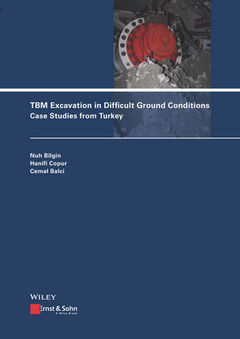TBM Excavation in Difficult Ground Conditions Case Studies from Turkey
Auteurs : Bilgin Nuh, Copur Hanifi, Balci Cemal

Acknowledgements IX
About the Authors XI
1 Introduction 1
2 Geology of Turkey and Istanbul, expected problems, some cuttability characteristics of the rocks 3
2.1 Introduction 3
2.2 Geology of Turkey 3
2.3 Geology of Istanbul 4
2.4 TBM performance in different projects in Istanbul 6
2.5 Description of geological formations in Istanbul, physical and mechanical properties 8
2.6 Full-scale linear rock cutting tests with disc cutters in rock samples collected from different projects in Istanbul 40
2.7 Conclusions 68
References 70
3 Difficult ground conditions dictating selection of TBM type in Istanbul 73
3.1 Introduction 73
3.2 Case study of open TBM in complex geology (1989), in Baltalimani tunnel: Why open type TBM failed 73
3.3 Double shield TBM in the Istanbul–Moda collector tunnel, 1989/90 80
3.4 Double shield TBM working without precast segment, difficulties in difficult ground: Tuzla-Dragos tunnel in Istanbul 80
3.5 Difficulties in using slurry TBMs in complicated geology, Marmaray tunnel project 84
3.6 Difficulties in single-shield TBM working in open mode in complex geology: An example from Kadikoy–Kartal metro tunnel 86
3.7 Eurasia tunnel excavated by a large diameter slurry TBM 88
3.8 Conclusions 88
References 90
4 Difficult ground conditions affecting performance of EPB-TBMs 91
4.1 Introduction 91
4.2 Factors affecting performance of EPB-TBMs 92
4.3 Performance prediction of EPM TBMs in difficult ground conditions 93
4.4 Conclusions 106
References 107
5 Selection of cutter type for difficult ground conditions 109
5.1 Introduction 109
5.2 Comparative studies of different type of cutters for Tuzla–Dragos tunnel in Istanbul – test procedure and results 109
5.3 The inefficient use of tungsten carbide studded disc cutters in the Marmaray–Istanbul project 114
5.4 Conclusions 115
References 116
6 Effects of North and East Anatolian Faults on TBM performances 117
6.1 Introduction 117
6.2 Kargi tunnel 117
6.3 Gerede tunnel 118
6.4 Dogancay energy tunnel 120
6.5 Nurdagi railway tunnel 122
6.6 Uluabat energy tunnel 123
6.7 Tunnels excavated by drill and blast methods 126
6.8 Conclusions 127
References 128
7 Effect of blocky ground on TBM performance and the mechanism of rock rupture 129
7.1 Introduction 129
7.2 Mechanism of rock rupture and face collapse in front of the TBM in the Kozyatagi–Kadikoy metro tunnels in Istanbul 131
7.3 Conclusions 140
References 141
8 Effects of transition zones, dykes, fault zones and rock discontinuities on TBM performance 143
8.1 Introduction 143
8.2 Beykoz sewerage tunnel 143
8.3 Kartal–Kadikoy metro tunnels, methodology of understanding critical zones 153
8.4 Conclusions 163
References 165
9 Squeezing grounds and their effects on TBM performance 167
9.1 Introduction 167
9.2 Basic works carried out on squeezing ground 167
9.3 Uluabat tunnel 168
9.4 Kargi Tunnel 179
References 186
10 Clogging of the TBM cutterhead 189
10.1 Introduction 189
10.2 What is clogging of a TBM cutterhead and what are the clogging materials? 189
10.3 Testing clogging effects of the ground 189
10.4 Mitigation programs to eliminate clogging 191
10.5 Clogging of TBMs in Turkish projects 192
10.6 Conclusions 207
References 208
11 Effect of high strength rocks on TBM performance 211
11.1 Introduction 211
11.2 Beykoz sewerage tunnel, replacing CCS disc cutters with V-type disc cutters to overcome undesirable limits of penetration for a maximum limit of TBM thrust 211
11.3 Nurdagi tunnel, full-scale cutting tests to obtain optimum TBM design parameters in very high strength and abrasive rock formation 213
11.4 Beylerbeyi–Kucuksu wastewater tunnel, TBM performance in high strength rock formation 216
11.5 Tuzla-Akfirat wastewater tunnel, TBM performance in high strength rocks 221
11.6 Conclusions 222
References 223
12 Effect of high abrasivity on TBM performance 225
12.1 Introduction 225
12.2 Determination of the abrasivity 229
12.3 Empirical prediction methods for disc cutter consumption 232
12.4 Examples of cutter consumptions on TBMs in Turkey 239
12.5 Conclusions 269
References 271
13 Effect of methane and other gases on TBM performance 273
13.1 Properties of methane 273
13.2 Selimpasa wastewater tunnel, methane explosion in the pressure chamber of an EPB-TBM 275
13.3 Gas flaming in the Silvan irrigation tunnel 284
13.4 More gas-related accident examples for mechanized tunneling 287
13.5 Conclusions 290
References 291
14 Probe drilling ahead of TBMs in difficult ground conditions 293
14.1 Introduction 293
14.2 General information on probe drilling and previous experiences in different countries 293
14.3 Melen water tunnel excavated under the Bosphorus in Istanbul 295
14.4 Methodology of predicting weak zones ahead in the Melen water tunnel 297
14.5 Kargi energy tunnel 308
14.6 Conclusions 316
References 318
15 Application of umbrella arch in the Kargi project 321
15.1 Introduction 321
15.2 General concept of umbrella arch and worldwide application 321
15.3 Methodology of using umbrella arch in the Kargi project 322
15.4 Criteria used for umbrella arch in the Kargi project and the results 325
15.5 Conclusions 330
References 331
16 Index 333
Prof. Dr. Hanifi Copur works as an academician in the Mining Engineering Department of the Istanbul Technical University. He is an expert for mechanical mining and tunneling and is a board member of the Turkish Tunneling Society.
Prof. Dr. Cemal Balci is professor at the Mining Engineering Department of Istanbul Technical University, and has worked on many national and international implementation and research projects concerning mechanized mining and tunneling technologies. He is a board member of the Turkish Tunneling Society.
Date de parution : 12-2016
Ouvrage de 354 p.
17.3x24.4 cm


